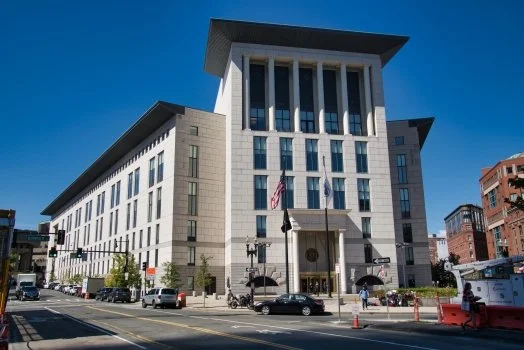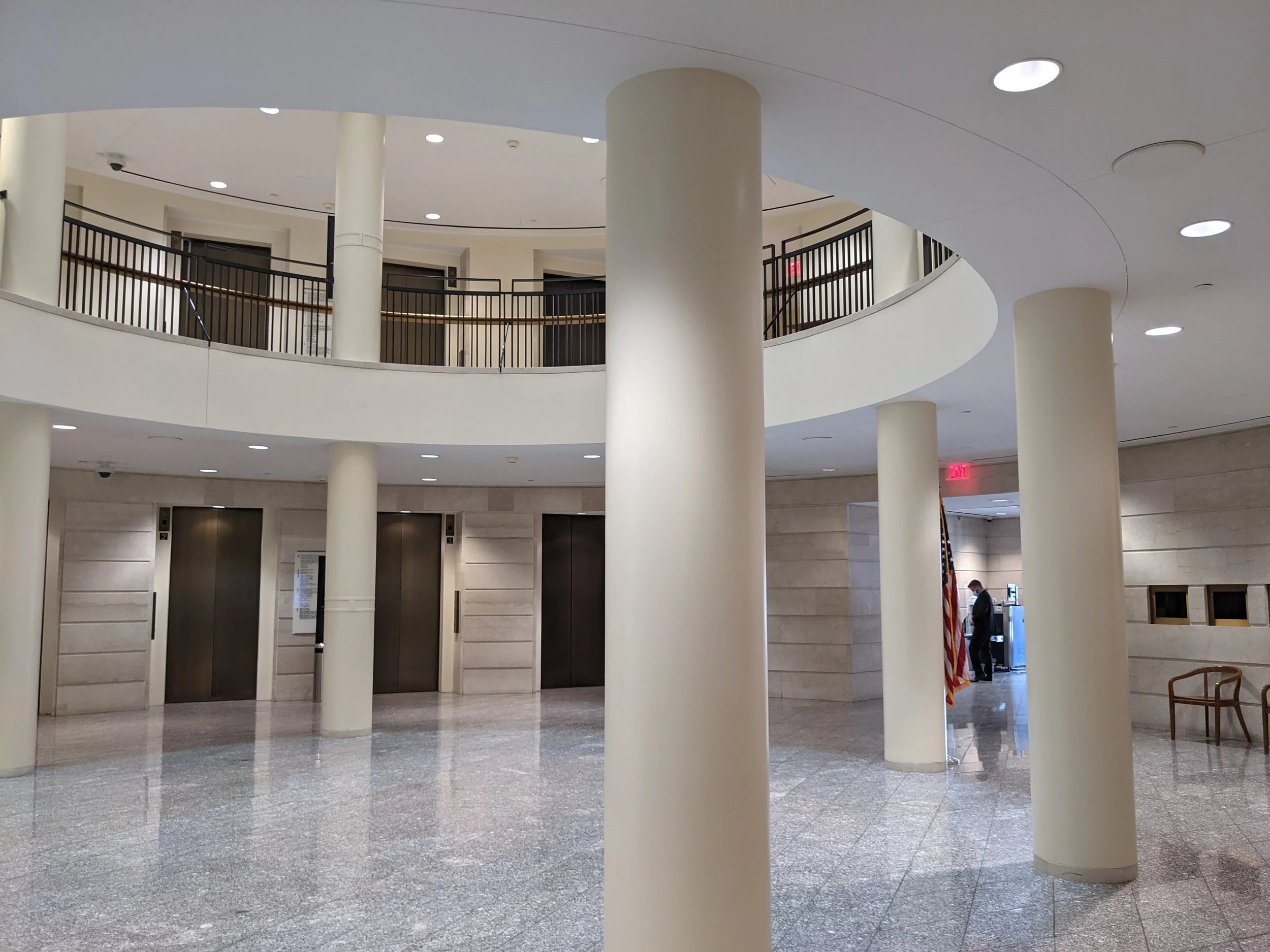
Improving the Wayfinding User Experience in Massachusetts Courts
A mixed-methods study for Bentley University project sponsor, The Massachusetts Court System
Project Summary
This study stemmed from previous research conducted by Dr. Demetrios Karis and researchers in his Field Methods course at Bentley University. The previous report highlighted the need for a positive experience for visitors within the interior space of the courthouse, a greater awareness of services for self-represented litigants, better processes for forms and paperwork, and overall more education around court services and processes to visitors. For this study, a group of 6 researchers from the Fall 2021 Field Methods course took a deeper look at wayfinding in both the interior and exterior spaces of courthouses all over Massachusetts. We collected data using a variety of methods, including observations, shadowing court users, interviews with court employees, and informal interviews with users. The team visited 9 courts within 4 counties over a 3 month period. The study resulted in a formal report and presentation of insights and recommendations to 30 Court Stakeholders on how to improve wayfinding for a diverse population of users. Our findings are now being used to update wayfinding in courthouses all over MA to provide equitable justice for all.
The Challenge
The courts serve a range of people including those who are unfamiliar with the legal system, those with varying levels of English fluency and literacy (estimated at 22% in MA), and those with different cognitive and physical abilities. Many come into the courts with some level of stress which inhibits navigational skills. Poor wayfinding systems are also costly to the courts since court employees must spend time directing and assisting people.
Role and Responsibilities
I acted as a UX researcher on a team of 6. My responsibilities included:
Scoping and designing the study along with my colleagues
Developing an interview guide and conducting an interview with one court employee
Conducting literature reviews on wayfinding
Conducting observations at courthouses all over MA
Shadowing and interviewing users at one courthouse in MA
Synthesizing the findings of the study along with my colleagues
Developing recommendations
Writing the findings and recommendation sections of the final report
Presenting the recommendations to court stakeholders
The Process
1. Literature Review
We began this study by wrapping our heads around previous research that was done by Dr Karis and his students, as well as learning all we could about wayfinding best practices. We used a wayfinding study completed for the California court system to help orient ourselves. We understood that a wide variety of visitors enter the courthouses each day. Improving wayfinding for individuals with limited English proficiency and those with cognitive and physical disabilities improves the user experience for everyone else by extension. So we dug deep into the world of ADA and language accessibility. We also looked into the impacts of stress on navigation.
2. Guided Tour
With all this information sloshing around in our heads, we took a guided tour of the Edward Brooke Courthouse, a large multiplex courthouse in Downtown Boston. During this tour we began to understand more of the background of the study and started our observations of the building layout, signage, and digital displays.
We visited the Edward Brooke Courthouse in Downtown Boston.
3. Field Observations
Because wayfinding involves the built environment, we knew that we needed to actually go to courthouses to assess the user experience through observations. We wanted to see the physical layout of the courts, the signs, and how users interacted with the spaces. To standardize and organize our observations, we came up with an observation guide outlining the specific features we wanted to look for in each courthouse. We used the findings from our literature review and initial visit to design the observation guide. It included:
The architectural layout & organization of the building
Signage
Language accessibility
ADA accessibility
Modern wayfinding tools
Parking and arriving
Services
The first page of the observation guide we developed. It included helpful links to references.
We conducted observations at 9 courthouses in total, including 5 multiplex courthouses and 4 district courthouses. The court administration kindly allowed us to take photos as part of these observations, provided we did not include any people in the pictures.
4. Shadowing and Interview Court Users
We wanted to more closely observe visitors interacting with the environments. We set up an information table at 3 multiplex courthouses during busy periods and asked visitors if we could shadow them when they approached us. We asked as many questions as possible and took plenty of detailed notes. During these sessions, we also spoke with court employees such as court officers to better understand their role in wayfinding.
We shadowed court users at the Brooke Courthouse in Downtown Boston. The court administration kindly allowed us to take photos of the building provided we did not include any people in the pictures.
5. Interviews with Court Employees
We also wanted to understand the internal challenges to improving wayfinding within the MA Court System. We conducted five 30-45 minute Zoom interviews with court employees, including a Research Analyst, Facilities Supervisor, Court Service Center Manager, a Head Clerk for the Superior Courts and the Director of Workplace Rights and Compliance for the trial courts.
I conducted a remote interview over Zoom with the Director of Workplace Rights and Compliance. She provided a ton of information for accessibility in the courts.
Outcomes
We amassed a huge amount of data including observations, photos, and interviews. We coded this information and grouped our findings into overarching themes. In our 100+ page report, we presented the overall findings from the thematic analysis along with photos and quotes to support our findings. We also included a section offering more detailed findings for each courthouse we visited. Our recommendation section was especially strong. Understanding that the court was strapped for resources and had the potential for delays due to red-tape, we offered suggestions for both quick fixes as well as longer term projects.
We presented the findings to 30 employees of the MA Court System, including a supreme court justice. Our presentation was well received and the court is now in the process of making updates to each of the courthouses based on our recommendations.
Reflections
Besides this study being a crash course in wayfinding, it was also a crash course in the legal system. A lot of our secondary research was spent learning legal terms, such as the differences between probate and probation. It was also eye opening to the lack of accessibility in physical public spaces for those with disabilities and low english proficiency. I’m heartened that I could conduct this kind of study to provide equitable access to justice for all in MA.
If I could redo any part of this project it would be to make more time for secondary research. Wayfinding is a mature topic with long-established best practices - digging deeper may have saved us time visiting all the courthouses and allowed us to conduct an expert evaluation. However, I do believe that shadowing and speaking to court users was immensely valuable and allowed us to collect compelling evidence to inspire the court to take wayfinding challenges seriously. I also regret that we only focused our research on Eastern MA and felt that we neglected visiting courthouses, big and small, in other parts of the commonwealth. While we spoke with a variety of court users, we did not get a chance to speak to anyone with physical or cognitive disabilities. I think their feedback would have been enlightening and would have provided even more evidence for the need to improve wayfinding systems for court users across MA.
I was so inspired by this project, that I wrote a research paper on the implications of wayfinding on working memory and emotion. It was amazing to see how our findings were backed up by cognitive science.




